AMC 8 Daily Practice - Circles
Complete problem set with solutions and individual problem pages
A part of a circular glass mirror is damaged. To obtain a mirror of the same size, a worker uses a right-angle ruler for measurement as shown in the figure, and finds that and . What is the diameter of the circular mirror in centimeters?

- A.
- B.
- C.
- D.
- E.
It is known that the circumferential angle subtended by a diameter is a right angle.
Therefore, connecting forms a right triangle with , and is the diameter of the circular mirror.
By the Pythagorean theorem in :
Thus, the diameter of the circular mirror is centimeters.
As shown in the figure, is a rectangle with length , width , and diagonal length . It is rotated clockwise around point . Find the area swept by side .(Take )

- A.
- B.
- C.
- D.
- E.
The area swept by side is the area of the shaded part in the figure.
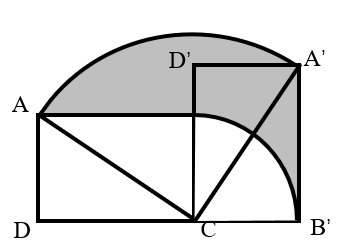
The area swept by = () -().
Since the area of is equal to the area of , this simplifies to: .
Calculating the areas of the sectors :
Answer: The areas swept by sides is square units.
Some squares are inscribed in a set of concentric circles, as shown in the figure. Given that the radius of the smallest circle is , what is the area of the shaded part in square centimeters? (Take )
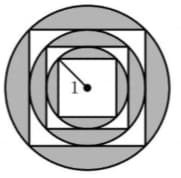
- A.
- B.
- C.
- D.
- E.
We calculate the area of the shaded part by dividing it into three parts:
the inner circle, the middle circle, and the outer circle.
the inner shaded area = the area of the inner circle - the area of the inner square:
The diameter of the inner circle is the side length of the middle square, which is . The diagonal of the middle square is the diameter of the middle circle.
Thus, the area of the middle shaded part is:
.
The area of the outer square is equal to the square of the diameter of the middle circle, which is . The square of the diagonal of the outer square is twice its area, so it is cm², which equals the square of the diameter of the outer circle.
Thus, the area of the outer shaded part is:
Adding up the three parts, the total area of the shaded part is:
Substituting :
Answer: The area of the shaded part is .
To cultivate students' practical ability, the school's biology interest group set up a circular exhibition hall during the project-based learning "Making a Mini Ecosystem". As shown in the figure, a monitor is installed at point on the circular edge of the hall, and its monitoring angle is . To observe every position in the exhibition hall, what is the minimum number of such monitors that need to be installed on the circular edge?
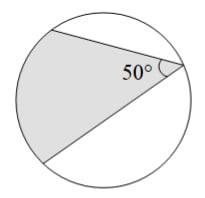
- A.
- B.
- C.
- D.
- E.
The monitoring angle of the monitor (a circumferential angle) is , so the central angle corresponding to the arc it can monitor is:
To cover the entire circular exhibition hall (with a total central angle of ), the minimum number of monitors needed is:
Since the number of monitors must be an integer, we round up.
Thus, at least monitors are required.
Given that the side length of square is and the side length of square is , and square has an inscribed circle , find the area of the circle.

- A.
- B.
- C.
- D.
- E.
It is known that the four right triangles are congruent.
The area of one such right triangle is:
Let the radius of circle be .
Since circle is the inscribed circle (incircle) of the right triangle, connecting the three vertices of the triangle to the center divides the triangle into three smaller triangles, each with a height equal to .
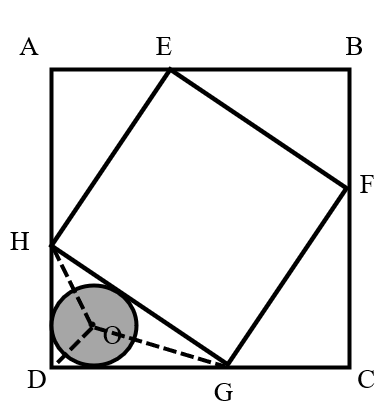
Factoring out , we get:
Notice that is equal to the sum of the side length of the large square and the side length of the small square, .
Substituting this in:
Thus, the area of circle is:
Answer: The area of the circle is square units.
As shown in the figure, quadrilateral is inscribed in circle , , is the midpoint of arc , and . What is the measure of ?
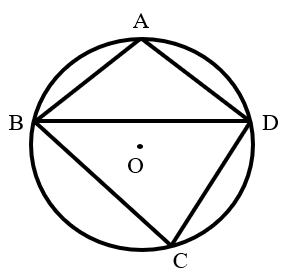
- A.
- B.
- C.
- D.
- E.
Connect , , , and .
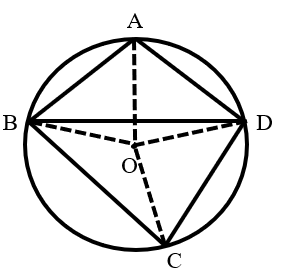
Since , the arcs they subtend are equal, so arc .
Because is the midpoint of arc , arc .
Therefore, arc .
is a circumferential angle subtended by arc , and .
The central angle subtended by the same arc is twice the circumferential angle, so .
The total degree measure of the circle is , so the sum of the central angles subtended by arcs , , and is: .
Since arc , their corresponding central angles are equal: .
is a circumferential angle subtended by arc , so it is half of the central angle : .
A rectangle is inscribed with two equal circles, each having an area of . A small circle is tangent to three figures (the two large circles and one side of the rectangle). What is the area of the small circle?
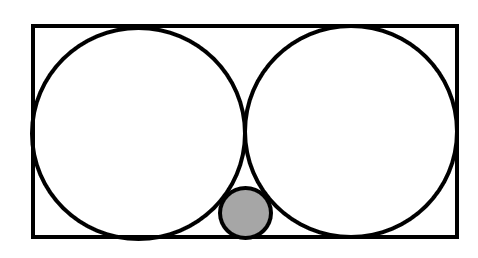
- A.
- B.
- C.
- D.
- E.
Let the radius of each large circle be and the radius of the small circle be .
Connecting the centers of the three circles forms a triangle.
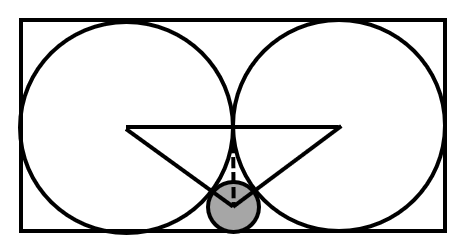
Based on the geometric relationship, we have the equation:
Expanding and simplifying the equation:
The area of a large circle is given by:
Substituting into the area formula of the large circle:
, ,
Thus, the area of the small circle is: .
With each of the three vertices of an equilateral triangle with a side length of centimeters as the center, arcs are drawn with a radius of centimeters. What is the perimeter of the shaded figure in centimeters? (Take )
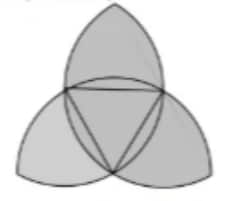
- A.
- B.
- C.
- D.
- E.
Each arc is of the circumference of a circle because the central angle of each arc is .
Therefore, the perimeter of the shaded figure is composed of such arcs.
The length of one arc is:
The total perimeter of the shaded figure is:
Thus, the perimeter of the shaded figure is centimeters.
- 1
- 2
- 3
- 4
- 5
- 6
- 7
- 8
